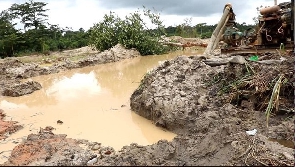Opinions of Saturday, 16 September 2023
Columnist: Michael Agbesi Kelly
The devastating impact of galamsey on cocoa farming in Ghana
Ghana is renowned for its high-quality cocoa, which has been a significant contributor to the country’s economy for decades. However, the rise of illegal mining, known as galamsey, has posed a severe threat to cocoa farming in Ghana.
This article explores the detrimental effects of galamsey on the cocoa industry and highlights the urgent need for action to protect this vital sector.
1. Environmental Degradation:
Galamsey operations involve the use of heavy machinery and chemicals, leading to extensive environmental degradation. Forests are cleared, water bodies are polluted with mercury and other toxic substances, and the soil is contaminated. These activities destroy the natural habitats of cocoa trees, disrupt the ecosystem, and compromise the long-term sustainability of cocoa farming.
2. Loss of Arable Land:
Cocoa farming requires vast areas of arable land, but galamsey encroaches upon these lands, rendering them unsuitable for cocoa cultivation. Illegal miners often excavate large pits and trenches, leaving behind barren landscapes that cannot support cocoa trees. The loss of arable land not only reduces cocoa production but also threatens the livelihoods of countless farmers who depend on cocoa farming for their income.
3. Reduced Crop Yields:
The pollution caused by galamsey has a direct impact on cocoa trees, leading to reduced crop yields. The use of toxic chemicals contaminates the soil, affecting soil fertility and the growth of cocoa trees. Additionally, the destruction of forests disrupts the natural ecosystem, reducing the shade and humidity required for optimal cocoa growth. As a result, cocoa farmers experience lower yields, diminishing their income and the country’s cocoa exports.
4. Increased Pest and Disease Infestation:
Galamsey activities create favourable conditions for the proliferation of pests and diseases that harm cocoa trees. The clearing of forests eliminates natural barriers that protect cocoa farms from pests, while the contamination of water bodies disrupts the natural balance of the ecosystem. These factors contribute to an increase in pest infestation, such as capsid bugs and black pod disease, further compromising cocoa production and quality.
5. Negative Economic Impact:
The decline in cocoa production due to galamsey has severe economic consequences for Ghana. Cocoa exports are a significant source of foreign exchange and contribute to the country’s GDP. The reduction in cocoa yields not only affects the income of individual farmers but also impacts the national economy, leading to decreased revenue, job losses, and a decline in the country’s global competitiveness in the cocoa market.
In conclusion, the devastating impact of galamsey on cocoa farming in Ghana cannot be overstated. The environmental degradation, loss of arable land, reduced crop yields, increased pest infestation, and negative economic consequences pose a significant threat to the sustainability of the cocoa industry. Urgent action is required to combat galamsey, including stricter law enforcement, community education, and sustainable mining practices.
Protecting cocoa farming is not only crucial for the livelihoods of farmers but also for Ghana’s economy and its reputation as a leading producer of high-quality cocoa.













